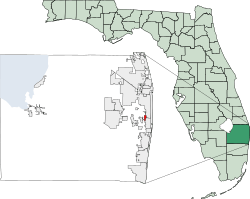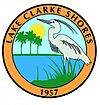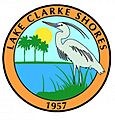Lake Clarke Shores, Florida facts for kids
Quick facts for kids
Lake Clarke Shores, Florida
|
||
|---|---|---|
| Town of Lake Clarke Shores | ||
|
||

Location of Lake Clarke Shores, Florida
|
||
| Country | ||
| State | ||
| County | ||
| Incorporated | July 1, 1957 | |
| Government | ||
| • Type | Council–Manager | |
| Area | ||
| • Total | 1.04 sq mi (2.68 km2) | |
| • Land | 0.92 sq mi (2.39 km2) | |
| • Water | 0.11 sq mi (0.29 km2) | |
| Elevation | 13 ft (4 m) | |
| Population
(2020)
|
||
| • Total | 3,564 | |
| • Density | 3,861.32/sq mi (1,491.35/km2) | |
| Time zone | UTC-5 (Eastern (EST)) | |
| • Summer (DST) | UTC-4 (EDT) | |
| ZIP code |
33406
|
|
| Area code(s) | 561, 728 | |
| FIPS code | 12-37800 | |
| GNIS feature ID | 0285226 | |
Lake Clarke Shores is a small town in Palm Beach County, Florida, United States. It is part of the larger Miami metropolitan area in South Florida. In 2020, about 3,564 people lived there.
The town is named after John Newton Clarke. He first claimed land here in 1897, hoping to grow pineapples, but it didn't work out. For many years, only a few people lived in the area. Then, in the late 1940s, a local lawyer named Walter Travers bought 250 acres of land. He planned to build a community around Lake Clarke.
In 1953, a new bridge was built over the West Palm Beach Canal. This helped the area grow even more. People heard that the city of West Palm Beach might try to take over their community. So, on April 10, 1956, residents voted to become an official town. The Florida Legislature made it official on July 1, 1957.
Today, Lake Clarke Shores is still a small town. It's mostly a place where people live and then travel to work in other cities. Most of its businesses are located along Forest Hill Boulevard, which is also known as State Road 882.
Contents
History of Lake Clarke Shores
Early Beginnings and Pineapple Farming
The town of Lake Clarke Shores got its name from John Newton Clarke. He was a grocer and postmaster in Lake Worth (now Lake Worth Beach). In 1897, he claimed about 139 acres of land on the east side of a lake. This lake was just west of West Palm Beach, and Clarke later named it after himself.
Clarke wanted to grow pineapples because it was a good business back then. He used his land for growing pineapples and for a packinghouse. However, the pineapple business in South Florida faced big problems around 1910. Also, when Henry Flagler's railway reached Key West in 1912, it became cheaper to bring pineapples from Cuba to the northern United States. By 1915, Clarke and many others stopped growing pineapples. After that, Clarke used his land as a place to go fishing.
In 1917, the West Palm Beach Canal was finished. This caused Lake Clarke to shrink and become more like a marsh. Its water level dropped by about 8 feet.
First Settlers and Community Growth
In the early 1930s, Zeb Vance Hooker and his family were the first to settle in what is now Lake Clarke Shores. They lived in a wooden shack by the southeast side of Lake Clarke. In 1946, Patsy Renolds built a house where Antigua Road is today. This is the oldest home in Lake Clarke Shores.
By the late 1940s, a local lawyer named Walter Travers visited the area. He bought the land along the lake from its owners. Travers wanted to buy more land that had been drained when the West Palm Beach Canal was built. The state of Florida first said no. But after talking with state officials, they offered him the land for $300 per acre. Travers tried to get a lower price for the lower-lying land. The state then decided to sell the land at an auction. Travers was the only one who bid, and he bought 250 acres on the northwest side of the lake for $10,000. A friend loaned him the money.
Travers then invested $5,000 into his plan to turn the area into a waterfront community. He brought in dredging equipment in 1949. At first, the community grew very slowly. Only three homes were built by 1952. One reason for the slow growth was that there was no bridge across the West Palm Beach Canal.
Palm Beach County Commissioner Lake Lytal helped convince the county to build a bridge. He knew that Travers would give $10,000 towards its construction. The bridge was finished in 1953. It connected Selby Road and Forest Hill Boulevard, making the whole road Forest Hill Boulevard. This bridge helped the area develop and grow much faster.
Becoming an Official Town
Rumors started that West Palm Beach wanted to take over the area. Because of this, 60 people formed the Lake Clarke Property Owners’ Association in 1955. They met to discuss their community's future. After agreeing on the name Lake Clarke Shores, residents met on April 10, 1956, to vote on becoming an official town.
The Florida Legislature was not meeting in 1956, so two-thirds of the voters had to agree. A total of 117 votes were cast, with 113 people voting yes and only 4 voting no. So, the idea passed! William H. McLaughlin was chosen as the first mayor of Lake Clarke Shores. Other officials were also elected. The Florida Legislature officially approved the town's creation on July 1, 1957, when the town received its State Charter.
Growth and New Buildings
Development continued quickly after Forest Hill Community High School opened in 1958, just across the canal from Lake Clarke Shores. The first count of the town's population was in 1960, showing 1,297 people. In its early years, Lake Clarke Shores was almost entirely homes. In 1962, a newspaper said that Forest Hill Baptist Church was the only non-residential building.
However, in the late 1960s, the town council started allowing businesses along Forest Hill Boulevard. The first business, a gas station, opened in June 1967. The town council had wanted a town hall for a long time. They finally approved building one on Barbados Road in the 1970s, and it opened in August 1974. About 10 years later, in May 1987, a building for the Lake Clarke Shores Police Department was finished.
Geography of Lake Clarke Shores
Lake Clarke Shores is located next to the cities of West Palm Beach and Lake Worth. You can get to these cities using Forest Hill Boulevard and Keller Road. The Village of Palm Springs is just west of the town.
The town's general borders are Interstate 95 to the east and Florida Mango Road to the west. Summit Boulevard is to the north (except for the Lake Patrick neighborhood), and 10th Avenue North is to the south (except for the Waterside neighborhood).
Lake Clarke Shores is in the east-central part of Palm Beach County. It's just west of the south end of West Palm Beach. It's also north and west of the north end of Lake Worth Beach, and east of Palm Springs.
The town covers about 1.0 square mile (2.6 square kilometers) in total. Most of this area is land, with about 0.1 square mile (0.26 square kilometers) being water.
Population and People
| Historical population | |||
|---|---|---|---|
| Census | Pop. | %± | |
| 1960 | 1,297 | — | |
| 1970 | 2,328 | 79.5% | |
| 1980 | 3,174 | 36.3% | |
| 1990 | 3,364 | 6.0% | |
| 2000 | 3,451 | 2.6% | |
| 2010 | 3,376 | −2.2% | |
| 2020 | 3,564 | 5.6% | |
| U.S. Decennial Census | |||
Population in 2020
In 2020, there were 3,564 people living in Lake Clarke Shores. There were 1,093 households and 864 families.
Most people in Lake Clarke Shores are White, making up about 59.96% of the population. About 32.69% of the people are Hispanic or Latino. Other groups include Black or African American (2.81%) and Asian (1.57%).
Population in 2010
In 2010, there were 3,376 people living in the town. There were 1,312 households and 903 families.
The average age in Lake Clarke Shores in 2010 was 46.5 years old. About 19.3% of the people were under 18 years old, and 17.8% were 65 or older. For every 100 females, there were about 107 males.
About 25.7% of households had children under 18 living with them. About 23.4% of all households were made up of one person living alone.
Parks and Fun Places
Lake Clarke Shores has five parks and places for recreation:
- Community Park
- Boat Ramp Park
- Memorial Park
- Pine Tree Park
- Town Hall Park
The town is also close to other fun places like Dreher Park, the Palm Beach Zoo, the South Florida Science Center and Aquarium, and the West Palm Beach Golf Course.
Education in the Area
Lake Clarke Shores does not have any public or private schools within its own borders. Students living in the northern part of town go to Meadow Park Elementary School and Conniston Community Middle School in West Palm Beach. Students in the southern part go to North Grade Elementary Schools and Lake Worth Middle School in Lake Worth Beach.
All students in the town attend Forest Hill Community High School. This school is just east of the town's boundaries. Nearby, in the village of Palm Springs, there is a special high school called the G-Star School of the Arts.
There are no colleges or universities in Lake Clarke Shores itself. However, nearby cities like Lake Worth Beach and West Palm Beach have several higher education schools. These include Keiser University, Palm Beach Atlantic University, and Palm Beach State College.
Lake Clarke Shores is also near the main branch of the Palm Beach County Library System.
News and Media
The Lake Worth Herald and Coastal/Greenacres Observer is a weekly newspaper that covers local news in Lake Clarke Shores. Residents also read The Palm Beach Post, which is published in West Palm Beach. The Palm Beach Post is one of the largest newspapers in Florida.
Lake Clarke Shores is part of the West Palm Beach–Fort Pierce television market. This means residents can watch TV stations like WPTV-TV (NBC), WPEC (CBS), WPBF (ABC), and WFLX (FOX). Many radio stations can also be heard in the town.
Town Services and Transportation
Getting Around
Forest Hill Boulevard, also known as State Road 882, runs east to west through the northern part of town. Florida Mango Road runs north to south through Lake Clarke Shores. Interstate 95 is along the eastern edge of the town. There is an entrance and exit ramp for I-95 on Forest Hill Boulevard, just outside the town.
The city of West Palm Beach has two train stations. The Tamarind Avenue station serves Tri-Rail and Amtrak trains. The Evernia Street station serves the faster Brightline trains. Another Tri-Rail station is in Lake Worth Beach. The closest airport is the Palm Beach International Airport in West Palm Beach. There are also Palm Tran bus stops along Forest Hill Boulevard.
Safety and Emergency Services
Lake Clarke Shores has its own police department. It has had full-time paid staff since November 1970, replacing its old volunteer force. In May 1987, the police department opened its own headquarters at the town hall complex. The department has 37 people, including 11 full-time members and Police Chief Wes Smith III.
Even though there are no longer volunteer police officers, the department still has a Citizen Observer Patrol Program. Volunteers in this program spend many hours patrolling the streets and helping with office work.
The police department building also has an Emergency Operations Center. This center allows direct communication with the Federal Emergency Management Agency and Palm Beach County Emergency Management. The town also uses the CodeRED Emergency Notification System. This system sends alerts about emergencies to residents' mobile devices. Fire and rescue services in Lake Clarke Shores are provided by the Palm Beach County Fire Rescue.
Images for kids
See also
 In Spanish: Lake Clarke Shores para niños
In Spanish: Lake Clarke Shores para niños




